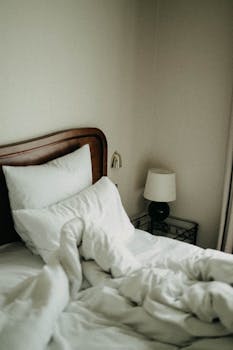
Unlocking the Secrets of Sleep: A Comprehensive Guide to Sleep Disorders
Sleep. That seemingly simple, restorative process is crucial for our physical and mental well-being. Yet, millions struggle with sleep disorders, impacting their daily lives significantly. Understanding the various types of sleep disorders, their symptoms, and available treatments is vital for improving overall health and quality of life. This article delves into the world of sleep disturbances, providing a comprehensive overview for better understanding and effective management.
What are Sleep Disorders?
Sleep disorders are conditions that disrupt normal sleep patterns and impair daytime functioning. They encompass a broad spectrum of conditions, ranging from occasional insomnia to chronic, debilitating problems. These disorders can affect anyone, regardless of age, gender, or background. The impact extends beyond simple tiredness; untreated sleep disorders can contribute to serious health issues, including cardiovascular disease, diabetes, obesity, and mental health problems.
Common Types of Sleep Disorders:
Several distinct sleep disorders exist, each with unique characteristics:
- Insomnia: This is the most prevalent sleep disorder, characterized by difficulty falling asleep, staying asleep, or experiencing non-restorative sleep. Chronic insomnia can lead to significant daytime fatigue and impairment.
- Sleep Apnea: This involves pauses in breathing during sleep, leading to repeated awakenings. Obstructive sleep apnea (OSA) is the most common type, caused by a blockage in the airway. Central sleep apnea involves the brain failing to send signals to the muscles that control breathing.
- Narcolepsy: This neurological disorder causes excessive daytime sleepiness and sudden, uncontrollable sleep attacks. It's often accompanied by cataplexy, a sudden loss of muscle tone triggered by strong emotions.
- Restless Legs Syndrome (RLS): RLS is characterized by an irresistible urge to move the legs, often accompanied by uncomfortable sensations. This typically worsens at night, disrupting sleep.
- Periodic Limb Movement Disorder (PLMD): This involves repetitive movements of the limbs during sleep, often without the individual's awareness. These movements can fragment sleep and lead to daytime sleepiness.
- Parasomnias: This category encompasses a range of abnormal behaviors during sleep, including sleepwalking, sleep talking, nightmares, and sleep terrors. These events typically occur during non-REM sleep.
- Circadian Rhythm Sleep Disorders: These disorders involve misalignment between the body's internal clock and the sleep-wake cycle. This can be caused by jet lag, shift work, or other factors disrupting the natural sleep-wake rhythm.
- Excessive daytime sleepiness: Feeling tired and drowsy throughout the day, despite adequate sleep at night.
- Difficulty falling asleep or staying asleep: Tossing and turning, frequent awakenings, or early morning awakenings.
- Snoring: Loud snoring, often accompanied by pauses in breathing.
- Morning headaches: Waking up with headaches, often due to sleep apnea.
- Irritability and mood changes: Increased irritability, anxiety, or depression.
- Difficulty concentrating: Problems focusing and remembering things.
- Unrefreshing sleep: Waking up feeling tired and unrested despite seemingly adequate sleep.
- Sleepwalking or sleep talking: Engaging in unusual behaviors during sleep.
- Physical examination: Assessing for any underlying medical conditions.
- Sleep history: Detailed information about sleep patterns and symptoms.
- Polysomnography (PSG): An overnight sleep study that monitors brain waves, heart rate, breathing, and other physiological parameters during sleep.
- Multiple Sleep Latency Test (MSLT): A daytime nap study used to assess sleepiness and diagnose narcolepsy.
- Lifestyle changes: Improving sleep hygiene (regular sleep schedule, comfortable sleep environment), managing stress, and regular exercise.
- Cognitive Behavioral Therapy for Insomnia (CBT-I): A type of therapy that addresses the thoughts and behaviors that contribute to insomnia.
- Medication: Various medications are available to treat different sleep disorders, including sleep aids, antidepressants, and stimulants.
- Continuous Positive Airway Pressure (CPAP) therapy: A common treatment for sleep apnea, involving wearing a mask that delivers pressurized air to keep the airway open during sleep.
- Surgery: In some cases, surgery may be necessary to correct anatomical problems contributing to sleep disorders.
Symptoms of Sleep Disorders:
The symptoms of sleep disorders vary depending on the specific condition. However, common signs include:
Diagnosis and Treatment:
Diagnosis of sleep disorders often involves a combination of:
Treatment options for sleep disorders vary depending on the underlying condition and may include:
Conclusion:
Sleep disorders are a significant public health concern, impacting millions and negatively influencing their quality of life. Early recognition, accurate diagnosis, and appropriate treatment are crucial for managing these conditions effectively. If you suspect you have a sleep disorder, consult a healthcare professional or sleep specialist for evaluation and guidance. Don't underestimate the power of restorative sleep – it’s the foundation of a healthy and productive life. Take the initiative to prioritize your sleep and well-being. Your health depends on it.

